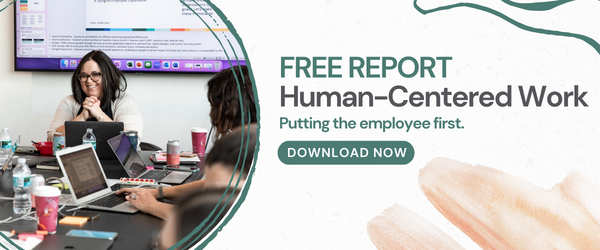Over the past few years, the relationship between employer and employee has changed drastically. Work itself has been completely revolutionized, and new ways of working that were implemented at the onset of COVID-19 as a temporary fix are now clearly here to stay.
Organizations need to reimagine their work to create safe, productive, and enjoyable jobs for employees in order for them to stay. Let’s look at what turnover looks like today and how employers can retain top talent when the playing field has completely shifted.
To attract the attention of younger potential employees, businesses need to shift their recruitment processes to meet the employee expectations of younger professionals who are used to interacting in a digital world ruled by apps. Apps like Tinder have shaped the mindset of Gen Y, and Gen Z, and people from those generations expect to be able to evaluate potential employers based on their company profiles, reviews, and ratings. They see the job market as a fluid entity where they are in charge, meaning employers need to emphasize flexibility, understanding, empathy, and a human-centered approach to working.
The Importance of Employee Retention
Employee retention strategies can help your organization to keep employees for the long term while, at the same time, boosting productivity, promoting higher levels of engagement, and ultimately, increasing revenue. There is a misconception that an organization only needs to implement retention strategies when there are high volumes of voluntary turnover. However, there is a halo effect regarding employee retention. Employee retention strategies can help your organization to keep employees for the long term while, at the same time, boosting productivity, promoting higher levels of engagement, and ultimately, increasing revenue. The hiring process is costly both in terms of resources and time.
Company Culture
Company leadership needs to show vision when it comes to driving cultural change. Providing a voice to our organization’s members is critical for developing a strong culture. Investing in people is an excellent way to move your organizational culture forward. Suppose you’re struggling with how to shift your organizational culture. In that case, you may want to consider bringing in an external service provider to audit your current culture and help improve your internal culture. Ultimately transparency and culture need to be aligned, and employees need to feel that they are truly being heard and understood.
Employee Loyalty
With a changing workforce, companies face new challenges regarding employee engagement and loyalty. While finding top talent isn’t difficult in a globalized, online working environment, the problem comes with employee loyalty and retention. Employers are being forced to set themselves apart to remain competitive. That means that the employee experience is just as important as your client or customer experience.
Applying customer experience strategy to employee retention and loyalty programs can start with segmenting employees based on their wants or needs. A job title isn’t enough. Companies need to understand the why’s of their employees. Some might be motivated by financial compensation, others prefer time or flexibility, and others need a little recognition or encouragement. The key is understanding their motivations and empowering management to share how much you value their employee contributions to the organization.
Hiring Costs
Another reason your organization should want to focus on employee retention and humanizing the workplace is that hiring is expensive! When employees don’t feel valued and look for new opportunities, not only are they not focusing on getting the work for your organization done, but they are also creating a potentially expensive problem for your operations and your bottom line.
Hiring new employees costs way more than just their salary. Recruitment, training, and office space (or company-issued hardware) can get expensive. Finding the right person can be tough on its own. You’ll have to pay to place an advertisement, pay human resources professionals to handle recruitment, review resumes, conduct interviews, and conduct any drug tests or background checks to ensure the potential new hire fits the company’s requirements.
Once you’ve found the perfect person to fit your vacancy, you’ll need to invest in training them. Training is a serious investment. It takes time for a new hire to learn, and it also requires current employees to focus their valuable time and attention on tasks that don’t necessarily pertain to their day-to-day work. This is all to say that foundational employee management is critical with the tinderization of work.
Employee Retention in a Post-Pandemic World
The U.S. Department of Labor recently issued a report that showed job openings skyrocketed to a two-year high in February of this year. As hiring surges, attrition is also on the rise, as mentioned in this article. Employees feel burnt out, which affects productivity, and more importantly, their well-being. Employees’ mental health should remain top of mind for employers. They are really the value of your entire organization, regardless of the sector. People are everything.
That being said, consider investing in operational changes that allow employees to work their best. For example, remote work options are pretty much a no-brainer now that we’ve experienced the shift to remote during COVID lockdowns. Flexibility is also crucial, and not just when it comes to working hours or schedules. Flexibility means employees have time to focus on all aspects of their lives, not JUST work. Give them choices, and they will choose to make your organization awesome!
Give Employees a Genuine Purpose
A feeling of purpose is critical for people to be motivated, especially regarding long-term motivation. It’s human nature. When people feel like they have a purpose, they work towards it. Here are a few tips on providing purpose to employees:
- Help them catch the vision or mission of your organization with clear company values that are communicated often to the team.
- Have managers lead by example by talking about the purpose they find in their own jobs.
- Remind people how valuable their work is by recognizing them with specific compliments showing how what they do is seen and valued.
Expand DEIB Efforts
Celebrating diversity and inclusion can go a long way when it comes to retention and employee empowerment, especially with younger generations entering the workforce. If you already have a successful DEIB program in place, you may want to consider growing it. Get your employees involved! Ask them what would help enhance their work experience and implement new ideas to show growth and solidarity with your team.
Read more about human-centered work by downloading our recent report. We analyzed the workplace over the past two years to share critical insights related to human resources management.


.png)



